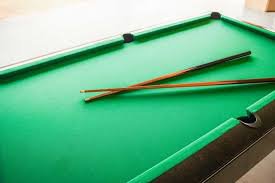So, you just went to go play a game of pool on your pool table and you notice a small scratch mark. This creates some concern as it can cause your shots to mess up, and you don’t want to break your winning streak. This makes you wonder if you should refelt your pool table before your next game. Or maybe you question, “why would I need to refelt a pool table?” if it’s only a scratch. Well that’s the thing, that small mark could cause issues moving forward including more rips and tears in the felt. Once it becomes to ripped, there is no playing any games until it’s fixed.
Refelting a Pool Table
First off, we need to discuss what exactly pool table refelting is and how would you refelt your pool table? Pool table refelting is the process of eliminating and replacing the felt or cloth cover on the top of the table. It is a common process that happens for all pool tables. Pool tables in need of refelting can be in hostels or hotels, as well as in other places. The easiest way to complete a pool table refelting is to hire a professional. That way, you can have someone visit your location instead of attempting to transport it by car to get the refelting done. It is important that whenever your pool table is moved, you ensure that it doesn’t damage your house by being dropped or hitting any walls.

Possible Customizable Features
Color: You can add various colors to your pool table and even install logos on them.
Standard Felt: Most people prefer the blended fabric that weighs about 21 ounces. It’s quite heavy. However, it plays very well. It is also regarded to have a better nap than worsted wool. Although you can expect some fuzzing to occur, the standard felt may last anywhere between 7 to 10 years with some normal wear and tear. Expect some pool table recovering along the way to keep the felt in mint condition.
Premium Felt: This is also known as worsted wool and is ideal for pool players that enjoy a faster table. The felt has nearly no nap, and the cloth is much tighter. The table balls tend to move much farther and faster. The worsted wool tends to last much longer, ranging from about 15 to 20 years. The fuzzing will occur much less compared to the standard felt material. Many tournaments use pool tables with worsted wool because of its amazing durability and performance. It also has a better aesthetic look, but it costs about the double the amount. Even if you get the worsted wool felt, you should still learn how to refelt a pool table.
Cost for Pool Table Felt Replacement: The cost varies from about $150 to $250 when trying to refelt a pool table. It will depend largely on the table size and manufacturer. Once you learn how to refelt your pool table, then begin considering the material and costs of the replacement.
The Cost and Process of Refelting Your Pool Table
If you’re planning to hire a professional to install your felt, it will usually cost between $175 to $225. Felt typically comes in several pieces, which include a piece for the cushions, surface, and table bed.
First, the professional will remove the tabletop felt, and have the new one stapled or glued onto the slate. High-quality tables usually have a backing somewhere on the slate to make gluing or stapling easy. If you decide to glue the felt on, it must be stretched across the table. If applied incorrectly, that can cause movement similar to a carpet.

Make sure to remove the existing table cushions and the current felt as well. You’ll need to trim the new cushion felts and have it wrapped and glued to every cushion. Then reattach the cushion to the side rails.
Last Minute Tips
Now you understand why you would need to refelt your pool table and what factors you would need to consider. Do keep in mind that you may need to figure out how often to refelt a pool table in order to keep your table in the best shape. Reaching out to a professional regarding any concerns you may have is always the best route of action.


